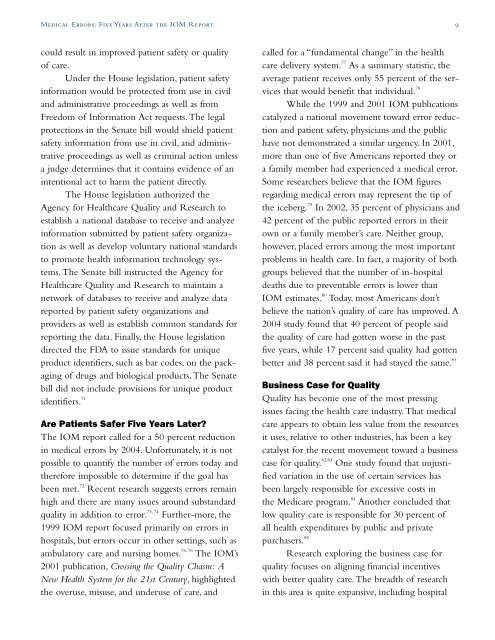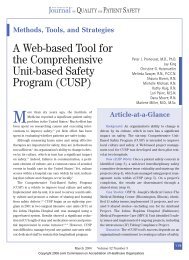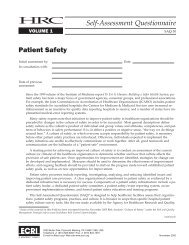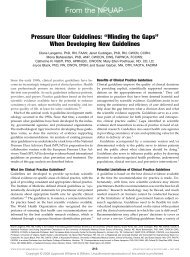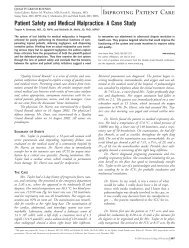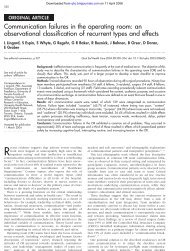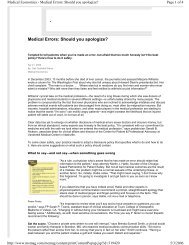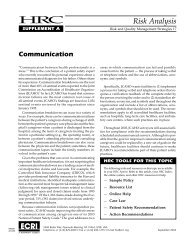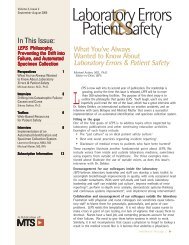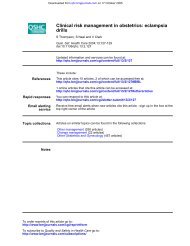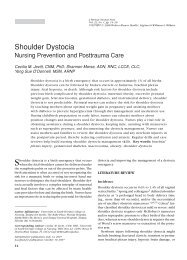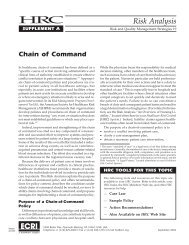Issue Brief - MCIC Vermont Patient Safety Documents
Issue Brief - MCIC Vermont Patient Safety Documents
Issue Brief - MCIC Vermont Patient Safety Documents
Create successful ePaper yourself
Turn your PDF publications into a flip-book with our unique Google optimized e-Paper software.
Medical Errors: Five Years After the IOM Report 9could result in improved patient safety or qualityof care.Under the House legislation, patient safetyinformation would be protected from use in civiland administrative proceedings as well as fromFreedom of Information Act requests. The legalprotections in the Senate bill would shield patientsafety information from use in civil, and administrativeproceedings as well as criminal action unlessa judge determines that it contains evidence of anintentional act to harm the patient directly.The House legislation authorized theAgency for Healthcare Quality and Research toestablish a national database to receive and analyzeinformation submitted by patient safety organizationas well as develop voluntary national standardsto promote health information technology systems.The Senate bill instructed the Agency forHealthcare Quality and Research to maintain anetwork of databases to receive and analyze datareported by patient safety organizations andproviders as well as establish common standards forreporting the data. Finally, the House legislationdirected the FDA to issue standards for uniqueproduct identifiers, such as bar codes, on the packagingof drugs and biological products. The Senatebill did not include provisions for unique productidentifiers. 71Are <strong>Patient</strong>s Safer Five Years Later?The IOM report called for a 50 percent reductionin medical errors by 2004. Unfortunately, it is notpossible to quantify the number of errors today andtherefore impossible to determine if the goal hasbeen met. 72 Recent research suggests errors remainhigh and there are many issues around substandardquality in addition to error. 73, 74 Further-more, the1999 IOM report focused primarily on errors inhospitals, but errors occur in other settings, such asambulatory care and nursing homes. 75, 76 The IOM’s2001 publication, Crossing the Quality Chasm: ANew Health System for the 21st Century, highlightedthe overuse, misuse, and underuse of care, andcalled for a “fundamental change” in the healthcare delivery system. 77 As a summary statistic, theaverage patient receives only 55 percent of the servicesthat would benefit that individual. 78While the 1999 and 2001 IOM publicationscatalyzed a national movement toward error reductionand patient safety, physicians and the publichave not demonstrated a similar urgency. In 2001,more than one of five Americans reported they ora family member had experienced a medical error.Some researchers believe that the IOM figuresregarding medical errors may represent the tip ofthe iceberg. 79 In 2002, 35 percent of physicians and42 percent of the public reported errors in theirown or a family member’s care. Neither group,however, placed errors among the most importantproblems in health care. In fact, a majority of bothgroups believed that the number of in-hospitaldeaths due to preventable errors is lower thanIOM estimates. 80 Today, most Americans don’tbelieve the nation’s quality of care has improved. A2004 study found that 40 percent of people saidthe quality of care had gotten worse in the pastfive years, while 17 percent said quality had gottenbetter and 38 percent said it had stayed the same. 81Business Case for QualityQuality has become one of the most pressingissues facing the health care industry. That medicalcare appears to obtain less value from the resourcesit uses, relative to other industries, has been a keycatalyst for the recent movement toward a businesscase for quality. 82,83 One study found that unjustifiedvariation in the use of certain services hasbeen largely responsible for excessive costs inthe Medicare program. 84 Another concluded thatlow quality care is responsible for 30 percent ofall health expenditures by public and privatepurchasers. 85Research exploring the business case forquality focuses on aligning financial incentiveswith better quality care. The breadth of researchin this area is quite expansive, including hospital


